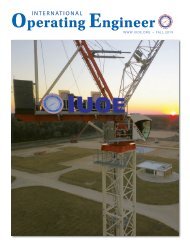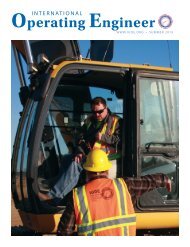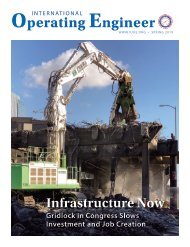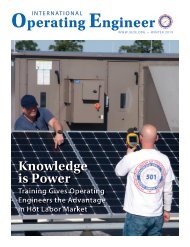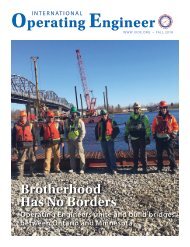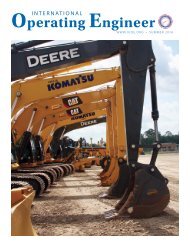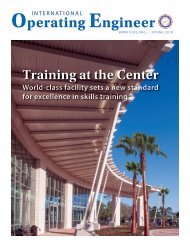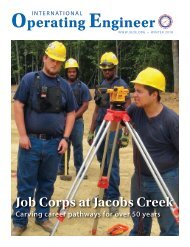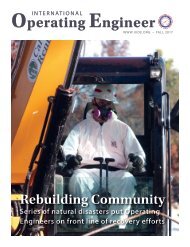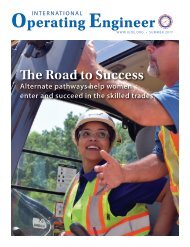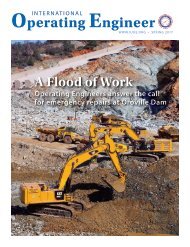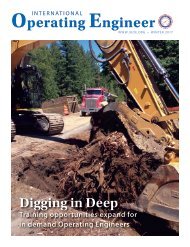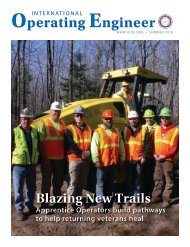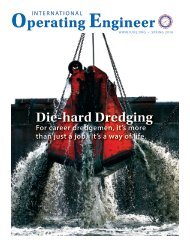125 Years Strong – An IUOE History
Celebrating the 125th Anniversary of the founding of the International Union of Operating Engineers
Celebrating the 125th Anniversary of the founding of the International Union of Operating Engineers
Create successful ePaper yourself
Turn your PDF publications into a flip-book with our unique Google optimized e-Paper software.
INTERNATIONAL UNION OF OPERATING ENGINEERS<br />
UNION’S JOURNAL INFORMING SINCE 1902<br />
The International Union of Steam Engineers published the<br />
very first issue of The International Steam Engineer, the union’s<br />
official journal, in 1902 with the debut of the July magazine that<br />
year. Initially a monthly publication, the journal was circulated<br />
“with the purpose of enabling members to win success in their<br />
chosen calling.”<br />
The earliest magazines continually aimed to inform readers<br />
of the latest developments in the engineering field and offered<br />
complete and detailed courses in mechanical drawing and<br />
mathematics. The very first issue of The International Steam<br />
Engineer gave a detailed account of work being performed by<br />
steam engineers who were excavating New York’s first subway<br />
and helping to build ships in Newport News, Virginia.<br />
Like the union it serves, the magazine evolved greatly over the years.<br />
Its name was changed in the late 1920s to simply The International<br />
Engineer to reflect the changing industry (as did the union’s name to<br />
the International Union of Operating Engineers in 1927), and it was<br />
changed again with the May 1956 issue <strong>–</strong> the “25 th Convention Issue”<br />
<strong>–</strong> to The International Operating Engineer, its title (sans “The”) as the<br />
union celebrates its <strong>125</strong> th anniversary in 2021.<br />
The February-March 1998 issue of the International Operating<br />
Engineer introduced a new, quasi-tabloid-style newspaper format<br />
to readers that expanded news, information and features for and<br />
about the union’s members as workers, consumers and citizens.<br />
Then the Winter 2006 issue again unveiled a new-look magazine,<br />
this time a more-visually appealing oversized-magazine format,<br />
with full color throughout, that would be published four times each<br />
year: winter, spring, summer and fall.<br />
The Reception Committee for the 1912 International Union of Steam Engineers Convention held in St. Paul, Minnesota, in September of that year.<br />
The implementation of the resolution was<br />
a monumental decision for the union, about<br />
which The Economic <strong>History</strong> of a Trade Union<br />
even declared:<br />
“The greatest heritage from the<br />
I.U.S.E. and the most important<br />
single event in the union’s history<br />
was the A.F.L. decision of November<br />
1907. … Had the jurisdiction of the<br />
I.U.S.E. remained limited to steam<br />
engine operation, the organization<br />
would have withered and died.”<br />
The union during its own convention that<br />
year also increased the per-capita tax on its<br />
locals to 20 cents per member, 3 cents of which<br />
was assigned to a defense fund <strong>–</strong> although while<br />
that represented a doubling of the tax, the<br />
receipts from locals to the international office<br />
did not immediately increase by more than<br />
25 percent. However, from 1908 to 1912, the<br />
union was able to keep up to four organizers in<br />
the field throughout North America. (1)<br />
The engineers’ union also began to actively<br />
participate in politics during that time<br />
to further its own objectives and those of<br />
organized labor overall. In the fall of 1908, the<br />
union endorsed and vigorously campaigned for<br />
the Democratic ticket and William Jennings<br />
Bryan for U.S. president (although Republican<br />
William Howard Taft won the election).<br />
In April 1910, troubles arose between the<br />
I.U.S.E. and miners in Montana, a source of<br />
friction that lasted several years. In the end, the<br />
miners’ union forced the dismissal of some 400<br />
steam engineers by claiming that the miners’<br />
agreement with the Amalgamated Copper<br />
Company covered steam engineers as well as<br />
other mine employees.<br />
In addition to the union’s dispute with the<br />
Western Federation of Miners, delegates to<br />
the 12 th <strong>An</strong>nual I.U.S.E. Convention held<br />
in Denver beginning September 12, 1910,<br />
discussed jurisdictional quarrels it was having<br />
with unions of electricians, longshoremen,<br />
steam railway engineers, ironworkers and<br />
LABOR OMNIA VINCIT<br />
WORK CONQUERS ALL



